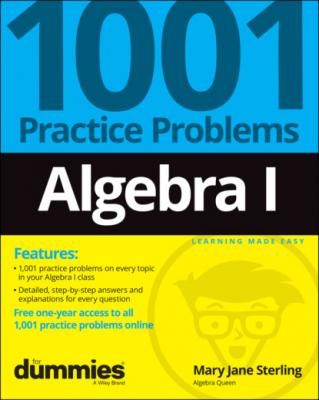Algebra I: 1001 Practice Problems For Dummies (+ Free Online Practice). Mary Jane Sterling
Читать онлайн.| Название | Algebra I: 1001 Practice Problems For Dummies (+ Free Online Practice) |
|---|---|
| Автор произведения | Mary Jane Sterling |
| Жанр | Математика |
| Серия | |
| Издательство | Математика |
| Год выпуска | 0 |
| isbn | 9781119883494 |
445.
446.
447.
448.
449.
450.
451.
452.
453.
454.
455.
Chapter 10
Factoring Binomials
A binomial is an expression with two terms. The terms can be separated by addition or subtraction. You have four possibilities for factoring binomials: (1) factor out a greatest common factor, (2) factor as the difference of perfect squares, (3) factor as the difference of perfect cubes, and (4) factor as the sum of perfect cubes. If one of these methods doesn’t work, the binomial doesn’t factor when using real numbers.
The Problems You’ll Work On
The problems in this chapter focus on the following:
Factoring when the two terms are the difference of perfect squares (both the numbers and the variables must be perfect squares)
Factoring when the two terms are the difference of perfect cubes (both the numbers and the variables must be perfect cubes)
Factoring when the two terms are the sum of perfect cubes (both the numbers and the variables must be perfect cubes)
Using more than one factorization technique in a problem
What to Watch Out For
When working through the steps necessary for factoring binomials, pay careful attention to the following:
Recognizing when a number is a perfect square so you can apply the factorization technique
Knowing enough of the perfect cubes to recognize them in binomials
Using the correct sign between the first and second terms of the trinomial when factoring sums and differences of cubes
Trying to factor the sum of perfect squares and mistaking it for the technique used with cubes
Using the correct exponents when factoring higher-power squares and cubes and dividing the exponents, not taking their root
Factoring the Difference of Perfect Squares
456–465 Factor each binomial using the pattern for the difference of squares.
456.
457.
458.
459.
460.
461.
462.
463.
464.
465.
Factoring the Sum or Difference of Two Perfect Cubes
466–475 Factor each as the sum or difference of perfect cubes.
466.
467.
468.
469.
470.
471.
472.
473.
474.
475.
Factoring More Than Once
476–495 Completely factor each binomial.
476.
477.
478.
479.
480.
481.
482.
